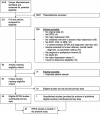Comparison of major depression diagnostic classification probability using the SCID, CIDI, and MINI diagnostic interviews among women in pregnancy or postpartum: An individual participant data meta-analysis
- PMID: 31568624
- PMCID: PMC7027670
- DOI: 10.1002/mpr.1803
Comparison of major depression diagnostic classification probability using the SCID, CIDI, and MINI diagnostic interviews among women in pregnancy or postpartum: An individual participant data meta-analysis
Abstract
Objectives: A previous individual participant data meta-analysis (IPDMA) identified differences in major depression classification rates between different diagnostic interviews, controlling for depressive symptoms on the basis of the Patient Health Questionnaire-9. We aimed to determine whether similar results would be seen in a different population, using studies that administered the Edinburgh Postnatal Depression Scale (EPDS) in pregnancy or postpartum.
Methods: Data accrued for an EPDS diagnostic accuracy IPDMA were analysed. Binomial generalised linear mixed models were fit to compare depression classification odds for the Mini International Neuropsychiatric Interview (MINI), Composite International Diagnostic Interview (CIDI), and Structured Clinical Interview for DSM (SCID), controlling for EPDS scores and participant characteristics.
Results: Among fully structured interviews, the MINI (15 studies, 2,532 participants, 342 major depression cases) classified depression more often than the CIDI (3 studies, 2,948 participants, 194 major depression cases; adjusted odds ratio [aOR] = 3.72, 95% confidence interval [CI] [1.21, 11.43]). Compared with the semistructured SCID (28 studies, 7,403 participants, 1,027 major depression cases), odds with the CIDI (interaction aOR = 0.88, 95% CI [0.85, 0.92]) and MINI (interaction aOR = 0.95, 95% CI [0.92, 0.99]) increased less as EPDS scores increased.
Conclusion: Different interviews may not classify major depression equivalently.
Keywords: Edinburgh Postnatal Depression Scale; depressive disorders; diagnostic interviews; individual participant data meta-analysis; major depression.
© 2019 The Authors. International Journal of Methods in Psychiatric Research published by John Wiley & Sons Ltd.
Figures


References
-
- American Psychiatric Association (1987). Diagnostic and statistical manual of mental disorders: DSM‐III (3rd ed., revised). Washington, DC: American Psychiatric Association.
-
- American Psychiatric Association (1994). Diagnostic and statistical manual of mental disorders: DSM‐IV (4th ed.). Washington, DC: American Psychiatric Association.
-
- American Psychiatric Association (2000). Diagnostic and statistical manual of mental disorders: DSM‐IV (4th ed., text revised). Washington, DC: American Psychiatric Association.
-
- Anthony, J. C. , Folstein, M. , Romanoski, A. J. , Von Korff, M. R. , Nestadt, G. R. , Chahal, R. , … Gruenberg, E. M. (1985). Comparison of the lay Diagnostic Interview Schedule and a standardized psychiatric diagnosis: Experience in eastern Baltimore. Archives of General Psychiatry, 42(7), 667–675. 10.1001/archpsyc.1985.01790300029004 - DOI - PubMed
Publication types
MeSH terms
Grants and funding
- K23 MH64476/MH/NIMH NIH HHS/United States
- 211374/Z/18/Z/WT_/Wellcome Trust/United Kingdom
- KRS-140994/CIHR/Canada
- K23 MH064476/MH/NIMH NIH HHS/United States
- MR/S035818/1/MRC_/Medical Research Council/United Kingdom
- RP-PG-1210-12002/DH_/Department of Health/United Kingdom
- K23 MH080290/MH/NIMH NIH HHS/United States
- DOH95F022/DH_/Department of Health/United Kingdom
- 071571/WT_/Wellcome Trust/United Kingdom
- MC_PC_MR/R01910X/1/MRC_/Medical Research Council/United Kingdom
- DOH94F044/DH_/Department of Health/United Kingdom
- WT_/Wellcome Trust/United Kingdom
- 082384/Z/07/Z/WT_/Wellcome Trust/United Kingdom
- RP-DG-1108-10012/DH_/Department of Health/United Kingdom
- UL1 TR001863/TR/NCATS NIH HHS/United States
- 5 R01HD045735/National Institute of Child Health and Human Development/International
- K23MH080290/MH/NIMH NIH HHS/United States
- R01 HD045735/HD/NICHD NIH HHS/United States
LinkOut - more resources
Full Text Sources
Medical

